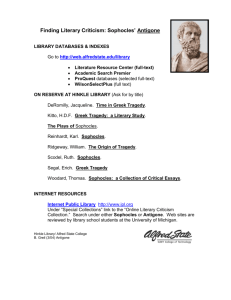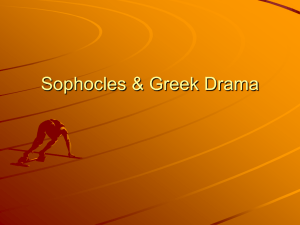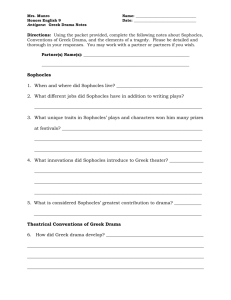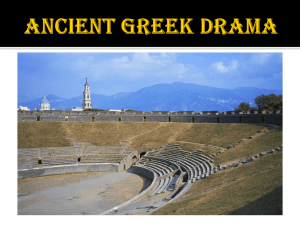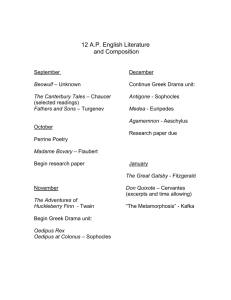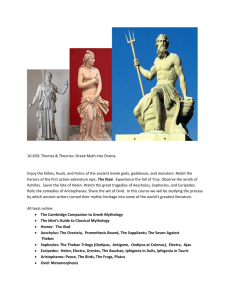Ancient Greek Drama presentation full detailbhavisha
advertisement
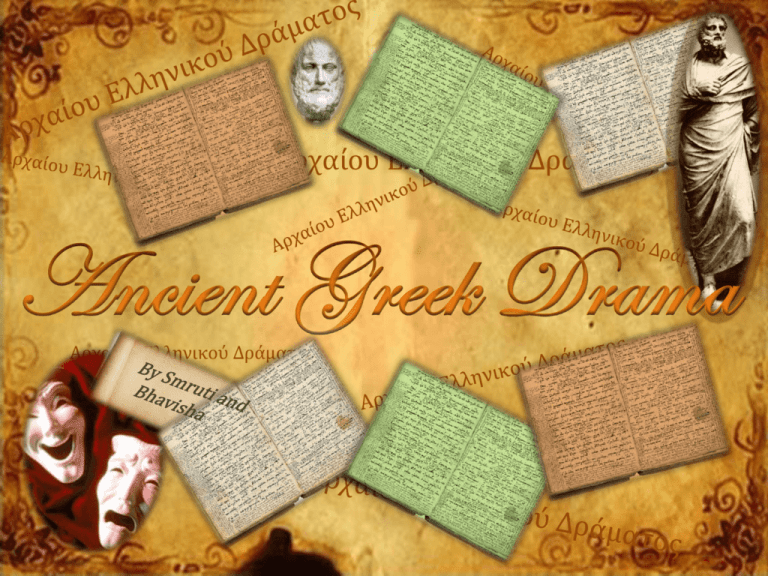
Αρχαίου Ελληνικού Δράματος Αρχαίου Ελληνικού Δράματος Ancient Greek literature slowly developed through religious rites back in 1200 BC. At that period of time Greece habited many tribes, of which a cult who lived in the area of Thrace stimulated the development of theatre drama. This cult worshiped a god by the name of Dionysus, who was the god of fertility and procreation. The cult practiced ritual celebrations which included alcoholic intoxications and human and animal sacrifices. Other rituals consisted of emotional portrayals which created different mental states. The Greeks found this ritual symbolic as they believed that it created catharsis. Catharsis is a purifying or figurative cleansing of the emotions, especially pity and fear, described by Aristotle as an effect of tragic drama on its audience. Hence people would come to see theatre as a way of releasing emotional release or purification. During the next six centuries this tribe spread further in Greece, which allowed its rituals to be further witnessed and appreciated by many other people. This spread of the Dionysus culture provoked the cult’s rites to become mainstream and symbolic. It is also known that the dithyramb which was a ‘choric hymn’, also had a major role in the rituals of this cult. It was first only a religious ceremony, performed by a leader, a band and dancers (some mythological half human and half goats). Shortly before 500BC, the Dithyramb became a great part of the many festivities and competitions that occurred in Greece and soon after a generation it attracted many poets into its art and form. It hence became an opportunity for people to present their poetic skills, and this slowly created epic poetry through which stories were told. They were also inspired by Greek mythology and the dithyramb slowly evolved into stories in play form – hence creating drama. TRAGEDY COMEDY Tragedy was initially formed in Athens during the 4th to 5th century. This was due to the development of radical ideas. In the previous centuries, the Greek were controlled by their religion in how they should think and behave. On the other hand in the 4th and 5th century new and different ideas were formed such as democracy, philosophy, science, mathematics and art. This period of time gave recognition to major philosophers such as Aristotle and Plato, with also other mathematicians and historians. There was therefore a huge growth in the way people thought especially after years of religion overpowering them. At this moment of time people hence started to question how nature actually worked and it was these tragedies which enabled playwrights to answer these questions. Here are some examples of the questions that many people asked themselves: Oedipus Rex – the arrogance of not accepting ones destiny. The Dithyramb had developed into new forms between 600 and 500 BC, of which Tragedy was significant due to its effect and the many strategies behind its existence. This is due to the fact that tragedies were produced to teach religious lessons and to hence portray to its audience the right and wrong paths to life. It is also not true that Tragedies were plays with a bad ending but were viewed as a form of ritual purification and therefore created catharsis. Usually, tragedies depicted the life journeys of people who happened to be on collision courses with society due to themselves or even fate. The tragic protagonist usually refused to comply to fate and hence opposed to believing that their lives were destined to consist of the opportunities and circumstances that fate had in line for them. These people were portrayed to have a main fault by the name of hubris (a greek and english word meaning false or overweening arrogance). Oedipus Rex – the arrogance of not accepting ones destiny. Agamemnon – the arrogance for assuming the right to kill. This therefore provoked the audience to believe that they the protagonist's collision with society was ultimately inevitable. DID YOU KNOW: That Hubris means – a false or overwhelming arrogance. Agamemnon – the arrogance for assuming the right to kill. 1.Prologue, which described the situation and set the scene 2. Parados, an ode sung by the chorus as it made its entrance 3. Five dramatic scenes, each followed by a Komos, an exchange of laments by the chorus and the protagonist 4. Exodus, the climax and conclusion Before 484 BC, drama was seen to consist of a trilogy of dithyrambs and a satyr play, which was presented in a more choral attire rather than the dramatic effects that drama’s now consist of. However, in 484 BC the playwright Aeschylus changed the dithyramb into drama by introducing an antagonist (second actor), props and scenery. Being a tragic playwright, Aeschylus’ plays were based on the idea of hubris which had many effects on the audience. For instance, through these many centuries, historians and dramatists, psychologists and crime writers all claim that Aeschylus like any other tragic playwright tried to portray the fact that the cause of evil and suffering is usually due to human arrogance; hubris. Themes of patricide and matricide were also the key reasons to unpleasant situations such as the parting of a family, which could be witnessed in the work of Aeschylus. Aeschylus died in during the beginning of the Periclean age, in 456 BC , during which playwrights such as Sophocles started to write some of the world’s most successful and recommendable plays. Euripides’ plays were not about Gods or royal people, but were about real people. He portrayed peasants along princes and gave them equal feelings. He also showed the realities of war and criticised religion. Sophocles was one of the most influential writers of Ancient Greece. He comes from a wealthy family and grew up in a small village called Colonus Hippius. The village, Colonus, later became a setting for Sophocles plays, and he used this setting to sometimes inspire his plays. He was the most awarded writer in the dramatic competitions of ancient Athens. According to ‘The Oxford Companion to English Literature’ Sophocles “Sophocles has not the epic grandeur of Aeschylus or Euripidies radical fire, but he is excellent at drawing character and evoking pathos.” He did many innovative things in his plays, traditionally a play at that time had twelve members in the chorus but Sophocles gave the chorus more depth and added three more members, to make it a total of fifteen in the chorus. He also introduced a third character or actor to the performance. Alongside his adaptions to the number of performers, he also put emphasis on drama between humans rather than between humans and gods. Moreover, his contribution also included the fact that he gave full detail to the dialogue in his plays in comparison to the choral parts and he insured that scenery was carefully painted and properly arranged. Sophocles’ language was also known to be quite harsh and involved but grand and majestic. His way of writing therefore contrasted to the phraseology of Aeschylus and the common diction of Euripides. Sophocles' Oedipus Rex is probably the most famous tragedy ever written. He introduced the play in Athens around 430 B.C. at the Great Dionysia which was a religious and cultural festival held in honour of the god Dionysus, and he won second prize. Sophocles lived and worked in a time where culture was given great significance, not only in the history of Athens but also in the sense of western democratic culture. During Sophocles' life, a culture based on the strength of language and writing were important features in Athens, it was known as the Golden Age of Athens. THE LANGUAGE OF SOPHOCLES •Greek diction is considered to be catergorised in three parts: 1) The “austere style” which is rough and archaic 2) The “flowery style” which has a soft and flowing attractiveness. 3) “Middle style” which is the in between, combining smoothness with power and grace and dignity.” It is considered that Sophocles’ language is “Middle style” and it has once been said that “Indeed, there is no Greek poet whose works exhibit in greater perfection the peculiar characteristics of the "middle style" -- the combination of supreme beauty of form with masculine strength and energy. The pre-eminence of Sophocles in these two points was universally recognized by the ancients”. • Sophocles language was also described by Aristophanes to be so sweet and he hence named Sophocles as “The Bee” as he said that his lips were “smeared with honey”. • “The various images, metaphors, epithets, and circumlocutions, in which the older poet luxuriated, are introduced by him only with a very sparing hand.” Tragedy is the “imitation of an action” according to “the law of probability or necessity.” In short Aristotle considers the plot to be the soul of a tragedy, with character in second place. The goal of tragedy is not suffering but the knowledge that issues from it, as the denouement issues from a plot. "Most important of all," Aristotle says, "is the structure of the incidents. For tragedy is an imitation not of men but of an action and of life, and life consists in action, and its end is a mode of action, not a quality . . . ." . Aristotle indicates that the medium of tragedy is drama, not narrative; tragedy “shows” rather than “tells.” According to Aristotle, tragedy is higher and more philosophical than history because history simply relates what has happened while tragedy dramatizes what may happen, “what is possibile according to the law of probability or necessity.” History thus deals with the particular, and tragedy with the universal. Events that have happened may be due to accident or coincidence; they may be particular to a specific situation and not be part of a clear cause-and-effect chain. Therefore they have little relevance for others. Tragedy, however, is rooted in the fundamental order of the universe; it creates a cause-and-effect chain that clearly reveals what may happen at any time or place because that is the way the world operates. Tragedy therefore arouses not only pity but also fear, because the audience can envision themselves within this cause-and-effect chain.
